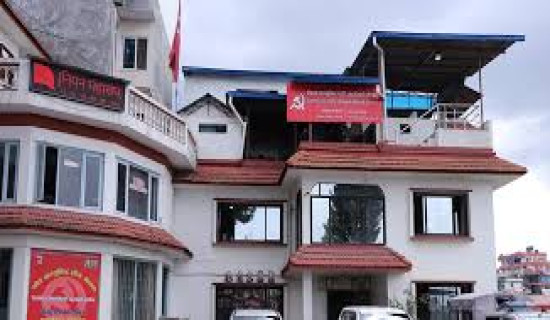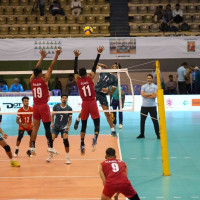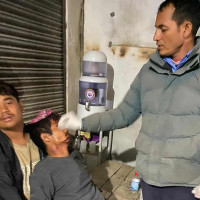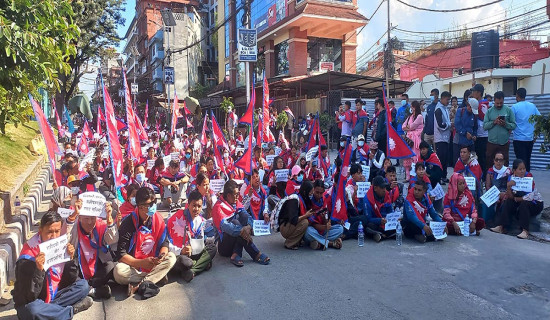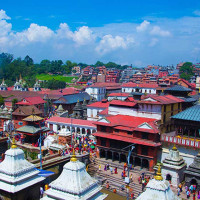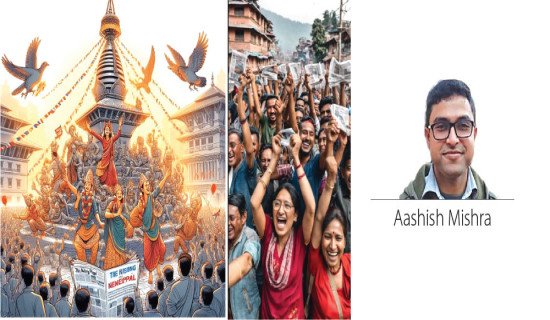- Saturday, 25 October 2025
Dispute brews over statue installation in Kirtipur
Lalitpur, Dec. 12: On December 1, amidst a celebratory procession, an idol of the Rato Machhindranath and the mythical Yaaka Misa was brought to Kirtipur and consecrated in a temple at Pyanga Thaa.
Four days later, on December 5, one of the main bodies responsible for managing the rituals related to the Machhindranath, Shree Hyagriv Bhairavnath and 32 Paneju Association (SHBPA), issued a statement condemning the act that, it said, was done without its consent and that went against religious doctrine.
This brought to light a dispute that had seemingly been going on away from the public eye for quite some time, and one that now threatens a crucial part of Lalitpur’s annual Machhindranath Jatra.
Every year, four days before the 48-feet tall chariot of the scarlet god, worshipped across the Kathmandu Valley as Karunamaya, is pulled to Jawalakhel from Thati, the Jala Paneju (the priest who sits to the right of Machhindranath in the chariot) walks barefoot from Patan to Pyanga Thaa to offer the deity’s flowers and Prasad to the woman Yaaka Misa to fulfil a promise made centuries ago and to uphold the ceremonial link Lalitpur has with Kirtipur.
“But now, we see no relevance in continuing this tradition,” the Panejus pronounced in the statement.
What caused this?
The Yaaka Misa is a living divinity believed by the people of Kirtipur to be the spouse of Bunga Dyo, the native name for Rato Machhindranath. She is supposed to represent the wife that Machhindranath left in the city with the promise to send her ritual items as mementoes every year on a specific day during his chariot festival – the custom that may now be discontinued.
A woman from a Maharjan family of Pyanga Thaa, located in a courtyard a short distance from the Uma Maheshwor Temple in Kirtipur Municipality, fulfils this role and, as a requirement, remains unmarried her whole life.
The present Yaaka Misa, which means ‘single woman’ in Nepal Bhasa, is 73-year-old Laxmi Kumari Maharjan. Her sister Ram Kumari Maharjan took the lead in commissioning and installing the now-controversial Machhindranath and Misa statues. And she told The Rising Nepal that the Panejus had been fully consulted beforehand.
“We had been talking with the Panejus since 2018,” she shared. “They were happy that we had approached them for permission and had given us the go-ahead. I don’t know why they are raising objections now.”
Maharjan also clarified that this initiative, which she undertook with her organisation the Sukhi Ga: Chhén Samaj, did not intend to harm culture. “On the contrary, we did this to preserve the connection Patan has with Kirtipur and keep the story of Bunga Dyo and Yaaka Misa alive for future generations.”
But intentions matter little and SHBPA feels that establishing Lord Karunamaya in Pyanga Thaa violates the ancient tradition of his seat exclusively remaining in Lalitpur.
To explain, the Association’s chair Yagya Ratna Shakya drew attention to an ancient legend: “When Machhindranath was first brought to Kathmandu, King Narendradev of Bhaktapur, Tantric Bandhudutta of Kantipur and Lalit Jyapu of Patan agreed to consecrate him in Lalitpur. Don’t you think King Narendradev or his descendants could have made a replica of the god and placed it in Bhaktapur? But they didn’t. There is a reason no one has copied the god’s likeness in more than a millennium.”
Shakya also denied that the Panejus had ever given Maharjan the green signal. “We have always been against this. The very first time they (Sukhi Ga: Chhén) came to us with this idea, we told them not to pursue it or to install a different form of Machhindranath.”
Karunamaya is considered to be one of 108 Lokeshwors and according to Shakya, the Panejus had advised Maharjan and her team to change the sculpture’s design and cast a different Lokeshwor which would still be a manifestation of Machhindranath but would not contravene religious sensibilities.
“But they chose to ignore us,” he complained.
Shakya also called the assumption that Machhindranath and Yaaka Misa were romantic partners inaccurate. “Once upon a time, a woman in Kirtipur grew restless that all her friends found husbands but she didn’t. So, she prayed to Bunga Dyo for help. This prompted Karunamaya to take the form of a young man and visit her,” he explained an alternate myth.
“But when she saw the handsome man, she could not control herself and took him captive. The Panejus later got him released and pledged to bring her flowers and offerings from him every year.”
Just as the husband-wife story is popular in Kirtipur, this story of the god reaching out to a devotee out of care is more prevalent in Lalitpur.
The Yaaka Misa, Shakya further said, is also one of three living Shakti Swarupa (energies) of Machhindranath – the other two being Balkumari or the Kumari of Bungamati and the Malini of Patan’s Sundhara.
What now?
The common element in both the Kirtipur and Patan myths though is that Machhindranath and the Yaaka Misa live apart and the latter receives ritual items from the former as a form of contact through the Jala Paneju. But now that both the divinities have been established together in the same place, there is no need for the Paneju to travel between the two cities to maintain that ‘contact’, the SHBPA argues. But Maharjan does not want this tradition broken and stressed that they did not mean any disrespect. Shakya, too, said that the Machhindranath priests did not desire a fight and wanted clarity on how best to proceed.
For now though, the matter has reached the Guthi Sansthan, the state body responsible for managing and protecting the social heritage and festivals of the country, and its Lalitpur branch has decided to bring all the stakeholders to the table and decide on how best to address the issue, Shakya informed.



